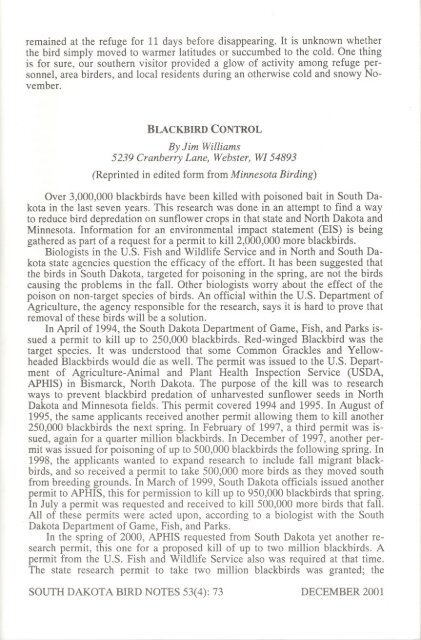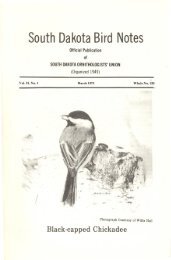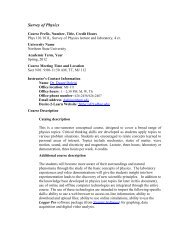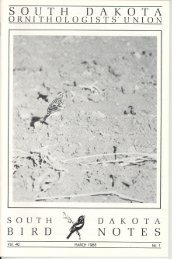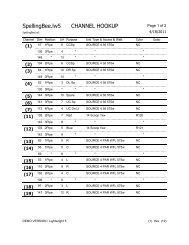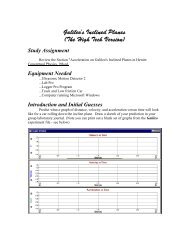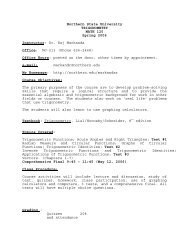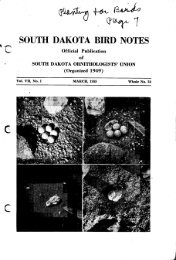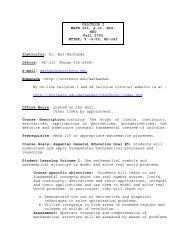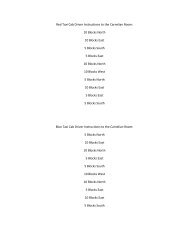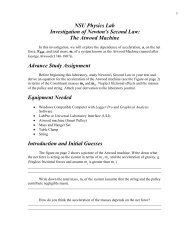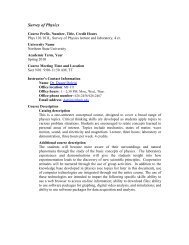--CRESTED CARACARA VISITS LACREEK NATIONAL WILDLIFEMike Artmann, Biological TechnicianLacreek National Wildlife RefugeREFUGENovember 20th2000 started out like many early winter mornings in southwesternSouth Dakota, clear and crisp. A resident of South Dakota for only ayear and a half, but a Minnesotan for 15 years growing up, I have seen a healthyshare of snowy, cold, wind-swept mornings. However, this particular morningwould be different. I have witnessed many unique things, while working as abiological technician for the U.S. Fish and Wildlife Service, stationed at theLacreek National Wildlife Refuge, but none as unique as the observation of aCrested Caracara that wind-swept Monday morning.I first saw the bird about 10 a.m., as I headed north from station headquarters.Upon seeing the large, unusual bird in the grove of ash trees, I quicklyslowed down and reached for the binoculars lying beside me on the truck seat.The bird sat still long enough for me to get a decent look. I remember thinking,"a Crested Caracara, you've got to be kidding!" Mildly stunned and not 100%sure that I had truly seen this bird, I quickly maneuvered the truck to a betterposition. Once atop a small hill, I put the 60x spotting scope on the bird. Sureenough, a Crested Caracara! Mer watching the bird for about 10 minutes, Iwent back to headquarters to share my strange discovery with other staff members.Needless to say, I received some skeptical glances and raised eyebrows.However, they soon verified the observation with their own eyes.Crested Caracaras occur most commonly in Mexico and South America. Inthe U.S., they typically occur only in southern Texas, southwestern Arizona, andin south central Florida. Although individuals have been reported as far north asOntario, Oregon, and Connecticut, these sighting are generally considered to bebirds escaping captivity. An extensive effort was conducted via e-mail and telephoneto determine if anyone reported a missing caracara. No reports came tolight. Prior to my sighting, Crested Caracaras had never been documented inSouth Dakota. The nearest documented record of a Crested Caracara to SouthDakota was in Wyoming, at Yellowstone National Park, in 1984. According toTerry McEneaney, ornithologist for Yellowstone Park, that individual remainedat the park for four days before disappearing.Crested Caracaras are generalists that are quite opportunistic in their choiceof food. Main prey items include insects, fish, reptiles, amphibians, birds, andmammals, and all types of carrion. The caracara at the refuge, as best as wecould determine, fed almost exclusively on several deer carcasses. Several daysafter the initial observation, I saw the bird actively walking and hopping in anarea burned early in the fall, apparently looking for food items. The bird wasvery deliberate and cautious, looking around frequently, as it moved. Caracarasare known to search of insects by using their feet to paw through dirt or overturncattle dung. Several crows were in the vicinity, however, I did not notice anysign of interaction, either friendly or combative, between the two species. Theonly other bird species I observed near the caracara was an immature Red-tailedHawk. The hawk displaced the caracara from a perch, however, no other interactionoccurred.The bird, believed to be a juvenile based on coloration of the head and feet,,ISOUTH DAKOTA BIRD NOTES <strong>53</strong>(4): 72 DECEMBER <strong>2001</strong>
emained at the refuge for 11 days before disappearing. It is unknown whetherthe bird simply moved to warmer latitudes or succumbed to the cold. One thingis for sure, our southern visitor provided a glow of activity among refuge personnel,area birders, and local residents during an otherwise cold and snowy November.BLACKBIRDCONTROLBy Jim Williams5239 Cranberry Lane, Webster, WI 54893(Reprinted in edited form from Minnesota Birding)Over 3,000,000 blackbirds have been killed with poisoned bait in South Dakotain the last seven years. This research was done in an attempt to find a wayto reduce bird depredation on sunflower crops in that state and North Dakota andMinnesota. Information for an environmental impact statement (EIS) is beinggathered as part of a request for a permit to kill 2,000,000 more blackbirds.Biologists in the U.S. Fish and Wildlife Service and in North and South Dakotastate agencies question the efficacy of the effort. It has been suggested thatthe birds in South Dakota, targeted for poisoning in the spring, are not the birdscausing the problems in the fall. Other biologists worry about the effect of thepoison on non-target species of birds. An official within the U.S. Department ofAgriculture, the agency responsible for the research, says it is hard to prove thatremoval of these birds will be a solution.In April of 1994, the South Dakota Department of Game, Fish, and Parks issueda permit to kill up to 250,000 blackbirds. Red-winged Blackbird was thetarget species. It was understood that some Common Grackles and YellowheadedBlackbirds would die as well. The permit was issued to the U.S. Departmentof Agriculture-Animal and Plant Health Inspection Service (USDA,APHIS) in Bismarck, North Dakota. The purpose of the kill was to researchways to prevent blackbird predation of unharvested sunflower seeds in NorthDakota and Minnesota fields. This permit covered 1994 and 1995. In August of1995, the same applicants received another permit allowing them to kill another250,000 blackbirds the next spring. In February of 1997, a third permit was issued,again for a quarter million blackbirds. In December of 1997, another permitwas issued for poisoning of up to 500,000 blackbirds the following spring. In1998, the applicants wanted to expand research to include fall migrant blackbirds,and so received a permit to take 500,000 more birds as they moved southfrom breeding grounds. In March of 1999, South Dakota officials issued anotherpermit to APHIS, this for permission to kill up to 950,000 blackbirds that spring.In July a permit was requested and received to kill 500,000 more birds that fall.All of these permits were acted upon, according to a biologist with the SouthDakota Department of Game, Fish, and Parks.In the spring of 2000, APHIS requested from South Dakota yet another researchpermit, this one for a proposed kill of up to two million blackbirds. Apermit from the U.S. Fish and Wildlife Service also was required at that time.The state research permit to take two million blackbirds was granted; theSOUTH DAKOTA BIRD NOTES <strong>53</strong>(4): 73 DECEMBER <strong>2001</strong>
- Page 1:
I .SOUTH DAKOTA IORNITHOLOGISTS'UNI
- Page 4 and 5:
fication of Birds of North America
- Page 6 and 7:
- - ~1180 individuals banded and 20
- Page 8 and 9:
L--: --..Dean, K. L. 1999. Stopover
- Page 10 and 11:
I was listening to an unusual sparr
- Page 12 and 13:
..of Black-backed Woodpeckers incre
- Page 14 and 15:
.~24 Sep Meade JLB ... Late [l5-Nov
- Page 16 and 17:
..-- --- --Yankton SVS; 02 Aug Robe
- Page 18 and 19:
..American Tree Sparrow Early: 03 O
- Page 20 and 21:
PubUshed bySOUl1l DAKOTAORNI1HOLOGI
- Page 22 and 23: SOUTH DAKOTA BIRD NOTES, the offici
- Page 24 and 25: ..ess that is being fought against.
- Page 26 and 27: White-fronted Goose 13% 6Snow Goose
- Page 28 and 29: Hairy Woodpecker 91% 41Black-backed
- Page 31 and 32: - - -Grzybowski, 1. A. 1999. Southe
- Page 33 and 34: en0ẹ..,::r:t:J~0~OJ....:;.:;t:JZ0
- Page 35 and 36: ~A GUIDE TO THE BIRDS OF THE PHILIP
- Page 37 and 38: Brookings KIE; 11 Feb Hughes RDORed
- Page 39 and 40: TJ; 20 Jan Hughes JSP, RFSPurple Fi
- Page 41 and 42: ~!I: ORNITHOLOGISTS'I SOUTH DAKOTAU
- Page 43 and 44: ..~PRESIDENT'S PAGEI had such a bla
- Page 45 and 46: -erably prior to consulting a field
- Page 47 and 48: SUBMITTEDFOR CONSIDERATIONEurasian
- Page 49 and 50: '"young cormorants, near flight sta
- Page 51 and 52: - --"only one genus of the family S
- Page 53 and 54: ~SEASONAL REPORTSThe 2001 Spring Se
- Page 55 and 56: ----KM; 08 Apr Butte JLBCinnamon Te
- Page 57 and 58: ,-----0Apr Minnehaha RBA; 17 May Be
- Page 59 and 60: Pileated Woodpecker Only Report: 15
- Page 61 and 62: 07 MayUnion RBA ...Late: 12 May McC
- Page 63 and 64: ,I~haha RFS, JSP; 11 May Meade EEMB
- Page 65 and 66: Contributing ObserversRBADBJLBKBAPB
- Page 67 and 68: .~lSD State Lists (31 December 2000
- Page 69 and 70: - ---- JSOU T H D A K 0 r~ORNITHOLO
- Page 71: ...~PRESIDENT'S PAGEThe September m
- Page 75 and 76: _INelson has cut back sunflower pla
- Page 77 and 78: problems." He explained that Wildli
- Page 79 and 80: within two hours.) Some non-target
- Page 81 and 82: '\of USFWS, Mountain-Prairie Region
- Page 83 and 84: takes three days for the bird to di
- Page 85 and 86: - ,..,rcording to Gamble.NORTH DAKO
- Page 87 and 88: ~IrSMALL RESEARCH GRANTS AVAILABLE
- Page 89 and 90: ';IWhite-faced Ibis reported from H
- Page 91 and 92: Whip-poor-will Reported from Lincol
- Page 93 and 94: Meade, Pennington and Stanley co.Ea
- Page 95 and 96: REPRFSSSNSSVSDRSDSRandy E. PodollRo


